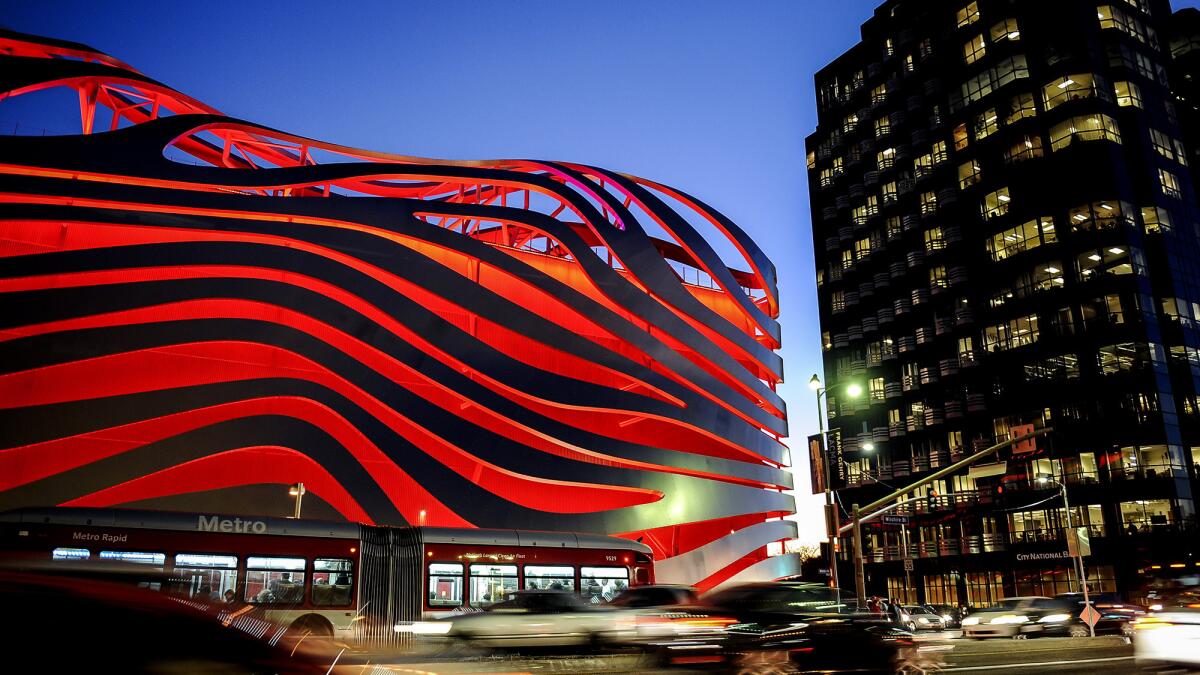Neighborhood Spotlight: Mid-Wilshire is alive with culture and ancient history

In 1921, developer A.W. Ross hatched a bold plan that would set the course for the way Angelenos would shop and live in the 20th century: He would buy up land on Wilshire Boulevard between La Brea and Fairfax avenues and build the retail hub of the future, one centered around the automobile.
Though critics scoffed, he believed he could draw customers from Beverly Hills and Hollywood to what was then the unfashionable hinterland of the city simply by combining luxury department store shopping with plenty of free parking. He was right.
What became known as the Miracle Mile was, by the late 1920s, a smash hit with upscale shoppers — no matter that it lay in the shadow of a vast and active oil field and that tar seeped up between the cracks in the sidewalks.
Freed from cramped, trolley-clogged downtown shopping districts, able to blithely flit along Wilshire Boulevard in their cars, bouncing from department store to upscale millinery to fashionable cafe and back again, Angelenos fell in love with mobility.
The Miracle Mile changed people’s mindset about where and how they could live. If you could shop outside of the city center, you could certainly live there, too.
Greater Mid-Wilshire boomed in the 1920s. An eclectic mix of housing catered to everyone from shopgirls to the heirs to great oil fortunes.
In the years after World War II, the district welcomed a new round of signature landmarks, when mid-rise office complexes like the Prudential Building began to appear on the boulevard, the massive apartment complex at Park La Brea was completed, and LACMA moved into new digs at the western end of the district.
Today the Mid-Wilshire district is a cultural center, with the Petersen Automotive Museum, the El Rey Theatre, the George C. Page Museum and LACMA soon to be joined by the Academy Museum of Motion Pictures. And, of course, the endless stream of tour buses that line up outside its wrought-iron fence every day is testament to the undying fascination of the La Brea Tar Pits.
Neighborhood highlights

Proof that L.A. does have culture: LACMA has a solid permanent collection, and it regularly hosts top-notch special exhibits. But let’s be honest: Everybody really loves it for the Urban Light installation out front.
When woolly mammoths roamed the earth: Where else can you watch as paleontology grad students dig ice age fossils out of tar with toothpicks? If you take the kids, prepare to answer awkward questions about the fate of the mama mammoth statue, which is perpetually sinking in the tar in front of her horrified offspring.
Art deco: From the May Co. Building on the west to the E. Clem Wilson Building on the east, the Miracle Mile has one of the best collections of intact art deco architecture in the world.
Neighborhood challenges
Beware the cone zone: Phase one of the Purple Line Extension, which will run under Wilshire Boulevard to La Cienega, is finally under construction. That’s fantastic news for commuters in the long term, but it will no doubt cause even more traffic headaches in the short term.
Expert insight
Bret Parsons, a Windsor Village resident and the architectural division director for Coldwell Banker Southern California, finds appeal in Mid-Wilshire’s history, family-oriented environment and singularity among the small pockets that make up the area.
“These are distinct neighborhoods that were all developed separately in the 1920s but grew together over the years,” said Parsons. “Each area — from Brookside to Fremont Place to Windsor Square — is noticeably different. Even when you drive around, you notice their unique personalities.”
Pedigreed homes on larger lots and a close proximity to downtown L.A. have fueled a resurgence in the area, Parsons said, and prospective buyers will need to move quickly in the market.
“Have a lot of cash, and be prepared to put a lot of down,” he advised. “Prices always remain high because there’s such little inventory.”
Market snapshot
Portions of the 90005, 90006, 90019 and 90036 ZIP Codes overlap the Mid-Wilshire area. In June, based on five sales, the median price for a single-family home in the 90005 ZIP was $1.3 million, according to CoreLogic. In the 90006 ZIP, based on two sales, the median price was $750,000; in the 90019 ZIP, based on 21 sales, the median price was $779,000; and in the 90036 ZIP, 17 sales resulted in a median price of $1.58 million.
Report card
Within the boundaries of Mid-Wilshire, as defined by the L.A. Times Mapping Tool, is Hancock Park Elementary, which had a score of 919 out of 1,000 in the 2013 Academic Performance Index. Queen Anne Place Elementary had a score of 813; Wilshire Crest Elementary had a score of 776; and New Los Angeles Charter scored 760. Los Angeles Senior High scored 643.




